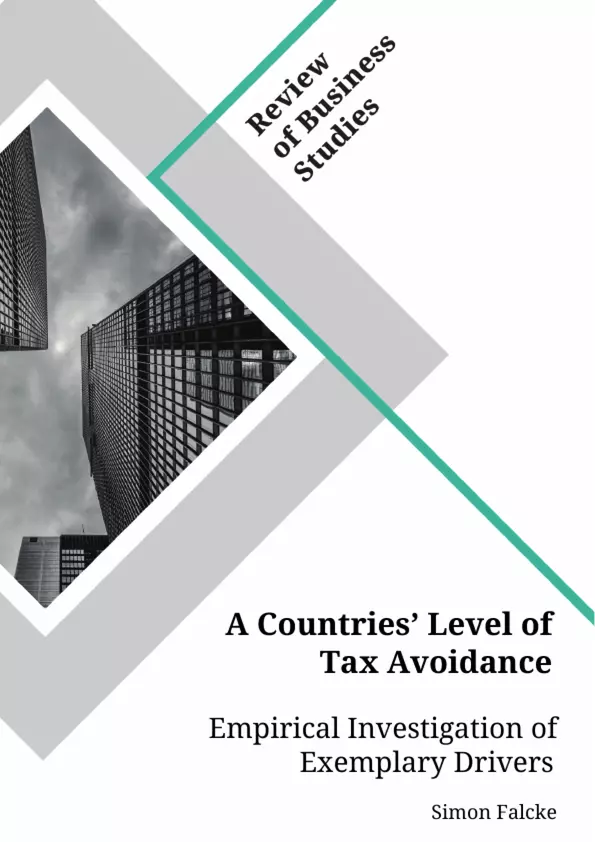This thesis contributes to the large literature of drivers of tax avoidance, for example tax system characteristics or the degree of tax incidence, by investigating which kind of firms drive the discovered difference in tax avoidance between countries. Thereby, it tries to answer the question which kind of firms benefit the most from common tax mechanisms and thus use them the most.
By doing so, this thesis focus on firm characteristics that are not part of the tax system itself, but rather are common characteristics associated with a difference in tax avoidance. Moreover, the research is complemented by investigating some tax related country characteristics to answer the question whether the observed firm-tax avoidance correlations differ depending on certain country-specific factors. The thesis therewith further completes the explanation for the difference between the degree of tax avoidance in different countries.
On January 22, 2019, the German political party Bündnis 90/Die Grünen published a study about the extent of tax avoidance in the European Union, revealing a gap between the effective tax rate paid by companies and the statutory tax rate in their home country. This gap between statutory tax rate and effective tax rate is one way of considering tax avoidance. There are other definitions as well, but overall tax avoidance can be seen as not paying the share of pre-tax income as taxes as intended by the government. In other words, tax avoidance is the attempt to legally reduce the tax burden paid to the government as much as possible.
Inhaltsverzeichnis (Table of Contents)
- Introduction
- Literature Review and Hypotheses Development
- Empirical Approach and Data
- Measures
- Regression Models
- Baseline Regression
- Regression with Country Characteristics
- Sample Selection and Descriptive Statistics
- Empirical Results
- Baseline Results
- Results with Country Characteristics
- Additional Analyses
- Robustness Test
- Conclusion
Zielsetzung und Themenschwerpunkte (Objectives and Key Themes)
This study explores the factors that influence tax avoidance across different countries. The objective is to investigate and quantify the impact of various drivers on companies' tax avoidance strategies, particularly focusing on the relationship between statutory tax rates, book-tax conformity, and tax avoidance.
- Tax avoidance practices and its impact on countries' fiscal revenue
- Key drivers of tax avoidance, including statutory tax rates and book-tax conformity
- Empirical analysis using regression models to quantify the relationships between tax avoidance and its drivers
- Exploring the role of country characteristics in influencing tax avoidance
- Evaluating the robustness of the empirical results through various testing procedures
Zusammenfassung der Kapitel (Chapter Summaries)
- Introduction: This chapter introduces the topic of tax avoidance, emphasizing the importance of understanding the difference between legal tax avoidance and illegal tax evasion. It also outlines the main objectives of the study and highlights the significance of investigating the factors influencing tax avoidance practices.
- Literature Review and Hypotheses Development: This chapter delves into existing research on tax avoidance, reviewing key studies and theories. It outlines the relevant hypotheses based on the literature review, setting the stage for the empirical investigation.
- Empirical Approach and Data: This chapter describes the methodological approach employed in the study, including the data sources, variable definitions, and regression models used to analyze the relationship between tax avoidance and its determinants.
- Empirical Results: This chapter presents the key findings of the study, outlining the results of the regression analysis and discussing the impact of various factors on tax avoidance levels. It examines the influence of statutory tax rates, book-tax conformity, and country characteristics.
- Robustness Test: This chapter assesses the robustness of the empirical results by conducting sensitivity analyses and testing the findings using alternative statistical methods. It aims to ensure the reliability and validity of the conclusions drawn from the study.
Schlüsselwörter (Keywords)
This study focuses on the concept of tax avoidance, specifically exploring the drivers of tax avoidance across countries. The key keywords and focus topics include tax avoidance, statutory tax rate, book-tax conformity, country characteristics, empirical analysis, regression models, and robustness testing.
- Quote paper
- Simon Falcke (Author), 2019, A Countries' Level of Tax Avoidance. Empirical Investigation of Exemplary Drivers, Munich, GRIN Verlag, https://www.grin.com/document/540163



